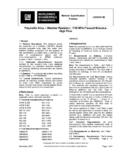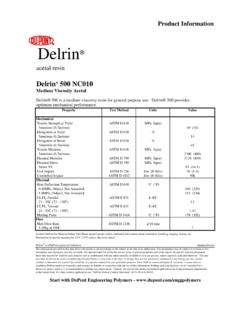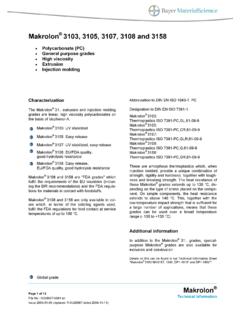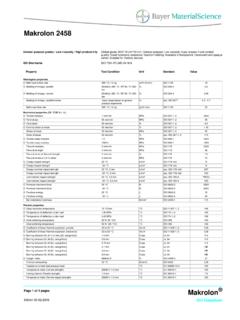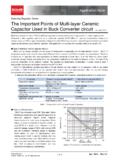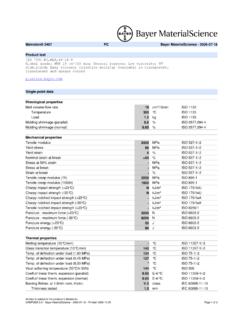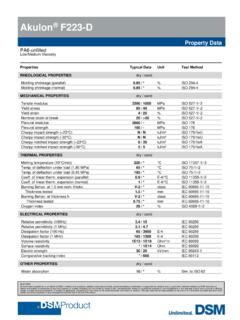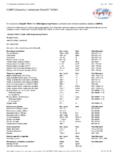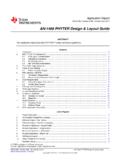Transcription of Makrolon 2805 - Talent Link
1 General purpose grades / Medium viscosityGlobal grade; MVR cm /10 min; General purpose; Medium viscosity; Easy release; Injectionmolding; Available in transparent, translucent and opaque colorsISO ShortnameISO 7391-PC,MR,61-09-9 PropertyTest ConditionUnitStandardValue-Rheological propertiesCMelt volume-flow rate300 C; kgcm /(10 min)ISO shrinkage, parallel60x60x2; 300 C / MT 80 C; 500bar%ISO shrinkage, normal60x60x2; 300 C / MT 80 C; 500bar%ISO shrinkage, parallel/normalValue range based on generalpractical experience%acc. ISO - mass-flow rate300 C; kgg/(10 min)ISO 113310 Mechanical properties (23 C/50 % r. h.)CTensile modulus1 mm/minMPaISO 527-1,-22400 CYield stress50 mm/minMPaISO 527-1,-266 CYield strain50 mm/min%ISO 527-1, strain at break50 mm/min%ISO 527-1,-2> 50 Stress at break50 mm/minMPaISO 527-1,-265 Strain at break50 mm/min%acc.
2 ISO 527-1,-2115 CTensile creep modulus1 hMPaISO 899-12200 CTensile creep modulus1000 hMPaISO 899-11900 Flexural modulus2 mm/minMPaISO 1782350 Flexural strength2 mm/minMPaISO 17898 Flexural strain at flexural strength2 mm/min%ISO stress at % strain2 mm/minMPaISO 17874 CCharpy impact strength23 CkJ/m ISO 179-1eUNCC harpy impact strength-30 CkJ/m ISO 179-1eUNCharpy notched impact strength23 C; 3 mmkJ/m acc. ISO 179-1eA70 PCharpy notched impact strength-30 C; 3 mmkJ/m acc. ISO 179-1eA12 CIzod notched impact strength23 C; mmkJ/m acc. ISO 180-A85 PIzod notched impact strength-30 C; mmkJ/m acc. ISO 180-A12 CCPuncture maximum force23 CNISO 6603-25400 CPuncture maximum force-30 CNISO 6603-26300 CPuncture energy23 CJISO 6603-260 CPuncture energy-30 CJISO 6603-265 Ball indentation hardnessN/mm ISO 2039-1115 Thermal propertiesCGlass transition temperature10 C/min CISO 11357-1,-2145 CTemperature of deflection under MPa CISO 75-1,-2125 CTemperature of deflection under MPa CISO 75-1,-2138 CVicat softening temperature50 N; 50 C/h CISO 306145 Vicat softening temperature50 N.
3 120 C/h CISO 306146 CCoefficient of linear thermal expansion, parallel23 to 55 C10-4/KISO 11359-1, of linear thermal expansion, transverse23 to 55 C10-4/KISO 11359-1, behavior UL 94 ( mm) [UL recognition] mmClassUL 94V-2 CBurning behavior UL 94 [UL recognition] mmClassUL 94V-2 Burning behavior UL 94 [UL recognition] mmClassUL 94V-2 Burning behavior UL 94 [UL recognition] mmClassUL 94 HBBurning behavior UL 94 [UL recognition] mmClassUL 94 HBBurning behavior UL 94 [UL recognition] mmClassUL 94 HBCO xygen indexMethod A%ISO 4589-227 Thermal conductivity23 CW/(m K)ISO to heat (ball pressure test) CIEC 60695-10-2135 Temperature index (Tensile strength)20000 h; mm CIEC 60216-1130 Halving interval (Tensile strength) mm CIEC index (Tensile impact strength)20000 h; mm CIEC 60216-1120 Halving interval (Tensile impact strength) mm CIEC 2805 Page 1 of 4 pagesMakrolon Edition DatasheetPropertyTest ConditionUnitStandardValue-Temperature index (Electric strength)20000 h; mm CIEC 60216-1135 Halving interval (Electric strength) mm CIEC temperature index (Tensile strength) [UL recognition] mm CUL 746B125 Relative temperature index (Tensile impact strength) [UL recognition] mm CUL 746B115 Relative temperature index (Electric strength) [UL recognition] mm CUL 746B125 Glow wire test (GWFI) mm CIEC 60695-2-12850 Glow wire test (GWFI) mm CIEC 60695-2-12850 Glow wire test (GWFI) mm CIEC 60695-2-12850 Glow wire test (GWFI) mm CIEC 60695-2-12900 Glow wire mm Cacc.
4 EDF HN60 wire mm Cacc. EDF HN60 of flame from small burnerMethod K and F; mmClassDIN 53438-1,-3K1, F1 Needle flame testMethod K; mmsIEC 60695-2-25 Needle flame testMethod K; mmsIEC 60695-2-25 Needle flame testMethod K; mmsIEC 60695-2-210 Needle flame testMethod F; mmsIEC 60695-2-260 Needle flame testMethod F; mmsIEC 60695-2-260 Needle flame testMethod F; mmsIEC 60695-2-2120 Incandescent bar testRatingIEC 60707-BHBH2/< 30 mmBurning rate (US-FMVSS)>= mmmm/minISO 3795passedFlash ignition temperatureProcedure B CASTM D1929470 Self ignition temperatureProcedure B CASTM D1929540 Electrical properties (23 C/50 % r. h.)CRelative permittivity100 Hz-IEC permittivity1 MHz-IEC factor100 Hz10-4 IEC 602505 CDissipation factor1 MHz10-4 IEC 6025090 CVolume resistivityOhm mIEC 600931E14 CSurface resistivityOhmIEC 600931E16 CElectric strength1 mmkV/mmIEC 60243-133 CComparative tracking index CTIS olution ARatingIEC 60112275 Comparative tracking index CTI MSolution BRatingIEC 60112125 Electrolytic corrosionRatingIEC 60426A1 Other properties (23 C)CWater absorption (Saturation value)Water at 23 C%ISO absorption (Equilibrium value)23 C; 50 % RH%ISO ISO 11831200 Water permeation23 C; 85 % RH; 100 m filmg/(m 24 h)ISO 15106-115 Gas permeationOxygen; 100 m filmcm /(m 24 h*bar)acc.
5 ISO 2556700 Gas permeationOxygen; m (1 mil) filmcm /(m 24 h*bar)acc. ISO 25562760 Gas permeationNitrogen; 100 m filmcm /(m 24 h*bar)acc. ISO 2556130 Gas permeationNitrogen; m (1 mil) filmcm /(m 24 h*bar)acc. ISO 2556510 Gas permeationCarbon dioxide; 100 m filmcm /(m 24 h*bar)acc. ISO 25564300 Gas permeationCarbon dioxide; m (1 mil) filmcm /(m 24 h*bar)acc. ISO 255616900 Bulk densityPelletskg/m ISO 60660 Material specific propertiesCViscosity numbercm /gISO 1628-459 Refractive indexProcedure A-ISO for transparent materials3 mm%ISO 14782< transmittance (clear transparent materials)1 mm%ISO 13468-289 CLuminous transmittance (clear transparent materials)2 mm%ISO 13468-289 Luminous transmittance (clear transparent materials)3 mm%ISO 13468-288 Luminous transmittance (clear transparent materials)4 mm%ISO 13468-287 Processing conditions for test specimensCInjection molding-Melt temperature CISO 294300 CInjection molding-Mold temperature CISO 29480 CInjection molding-Injection velocitymm/sISO 294200 Makrolon 2805 Page 2 of 4 pagesMakrolon Edition DatasheetCThese property characteristics are taken from the CAMPUS plastics data bank and are based on the international catalogue of basic data forplastics according to ISO 2805 Page 3 of 4 pagesMakrolon Edition DatasheetDisclaimerDisclaimer for Sales productsThis information and our technical advice - whether verbal, in writing or by way of trials - are given in good faith but without warranty, and this also applies where proprietary rights of third parties areinvolved.
6 Our advice does not release you from the obligation to verify the information currently provided - especially that contained in our safety data and technical information sheets - and to testour products as to their suitability for the intended processes and uses. The application, use and processing of our products and the products manufactured by you on the basis of our technicaladvice are beyond our control and, therefore, entirely your own responsibility. Our products are sold in accordance with the current version of our General Conditions of Sale and valuesUnless specified to the contrary, the values given have been established on standardised test specimens at room temperature. The figures should be regarded as guide values only and not asbinding minimum values. Kindly note that, under certain conditions, the properties can be affected to a considerable extent by the design of the mould/die, the processing conditions and noteUnder the recommended processing conditions small quantities of decomposition product may be given off during preclude any risk to the health and well-being of the machineoperatives, tolerance limits for the work environment must be ensured by the provision of efficient exhaust ventilation and fresh air at the workplace in accordance with the Safety Data Sheet.
7 Inorder to prevent the partial decomposition of the polymer and the generation of volatile decomposition products, the prescribed processing temperatures should not be substantially high temperatures are generally the result of operator error or defects in the heating system, special care and controls are essential in these : Business Development PlasticsBayer MaterialScience AG,D-51368 Leverkusen, 2805 Page 4 of 4 pagesMakrolon Edition Datasheet
